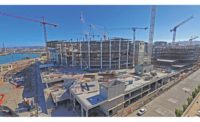City Scoop: Honolulu
Optimism Abounds for ‘Robust’ Honolulu Market

U.S. military infrastructure investment across the Pacific Region, with projects like the $2.8-billion Pearl Harbor Dry Dock 3 replacement, has buoyed the Honolulu construction market.
Photo courtesy Moffatt & Nichol

City Grill
Dean Kokubun
Vice President and Hawaii Business Unit Leader
Moffatt & Nichol
In Honolulu, the construction industry is looking forward with optimism. A strong recovery from the pandemic related setbacks is expected to accelerate as more project opportunities emerge in the next several years. Dodge Data & Analytics is projecting Honolulu construction starts to surpass $5 billion in 2024.
“The design and building industries in Hawaii continue to be very robust and the future for the construction sector looks bright,” says Dean Kokubun, vice president and Hawaii business unit leader for Moffatt & Nichol. The firm has been heavily invested in Hawaii’s construction sector. The firm’s $63.81 million in revenue made it the No.2 design firm in the state for 2023.
Honolulu non-building starts surged to reach $2.73 billion in 2022 and are expected to take a step back this year. Still, the upward trend over the past five years is expected to continue.
A dramatic example is the highways and bridges sector where construction starts reached $1.2 billion last year – more than nine times the amount in 2020. While starts are not expected to stay at that level, they should remain above the $1 billion mark this year and next.
“The State of Hawaii Dept. of Transportation continues to make significant investment in the state’s transportation system [highways, airports and harbors], including $1.5 billion over five years in federal highway formula funding for highways and bridges alone,” Kokubun notes.
One key piece of transportation infrastructure that came online this summer was the first phase of the largest public works project in Honolulu’s history, the $10-billion Skyline elevated rail system. The 10.8-mile section between Kualaka‘i and Aloha Stadium opened in June and construction continues to complete segments from Aloha Stadium to downtown Honolulu and, ultimately, Ala Moana Center. That, in turn, should spark long-awaited investment in those areas of the city.
“The New Aloha Stadium Entertainment District mixed-use real estate development in Halawa, Oahu, is moving into its request-for-qualifications and request-for-proposal phases and is expected to eventually generate more than $2 billion in construction spending,” Kokubun says.
Expectations for a boom in business are intertwined with practical concerns often exacerbated by Hawaii’s remoteness.
“One area of concern is the availability of qualified architects, engineers, scientists and a skilled construction workforce to keep up with current and future construction demand,” Kokubun says. “Although the situation is not new to the state, the sheer volume of work and the size of ongoing and future megaprojects in Hawaii and outlying areas could be a challenge for the local architecture, engineering and construction industry.”
Those pressures will add to concerns regarding housing scarcity in Honolulu and across the islands.
“The demand for residential housing—single family homes and condominiums—remains strong,” Kokubun says. So while Honolulu residential starts slipped to $565 million in 2022, a 45% drop from 2020, Dodge forecasts the sector to pick up considerably, more than doubling by 2024.
Another enormous driver for the region’s construction industry is the U.S. military, which has begun spending heavily on bolstering its infrastructure in the Pacific Region.
“The Dept. of Defense is undertaking a multibillion-dollar strategic investment in Hawaii, Guam and throughout the Indo-Pacific, which will keep engineers and construction contractors in Hawaii busy for years to come,” Kokubun explains.
Like many firms with a strong presence in Hawaii, Moffat & Nichol is working with Naval Facilities Engineering Systems Command (NAVFAC) throughout the Pacific on initiatives such as the U.S. Navy’s Shipyard Infrastructure Optimization Program and Pacific Deterrence Initiative.
The company is the prime marine and waterfront consultant to NAVFAC Pacific for its $2.8-billion Dry Dock 3 replacement project for the Pearl Harbor Naval Shipyard and Intermediate Maintenance Facility. The U.S. Navy selected a Honolulu-based joint venture of Dragados USA, Hawaiian Dredging Construction Co. and Orion Government Services LLC to handle the project in March.



